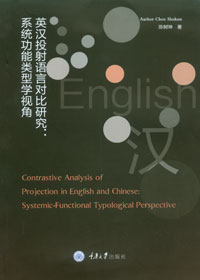英汉投射语言对比研究:系统功能类型学视角 - 中国高校教材图书网

|
书名: |
英汉投射语言对比研究:系统功能类型学视角
|
| ISBN: | 978-7-5689-2006-3 |
条码: | |
| 作者: |
陈树坤
相关图书
|
装订: | 0 |
| 印次: | 1-1 |
开本: | 16开 |
| 定价: |
¥82.00
折扣价:¥77.90
折扣:0.95
节省了4.1元
|
字数: |
666千字
|
| 出版社: |
重庆大学出版社 |
页数: |
316页
|
| 发行编号: | |
每包册数: |
|
| 出版日期: |
2020-06-27 |
|
|
| 内容简介: |
|
本书对投射语言现象(即传统语法所说的“转述语”)进行英汉对比分析,但是系统功能语言学认为投射一种意义,在语法各个级阶上有不同的实现方式。基于此观察,本书对投射意义在各个语法层次上的实现方式进行全面分析,其中包括投射小句复合体、情态附加语、连词以及环境成分。
|
| 作者简介: |
|
|
| 章节目录: |
Chapter OneIntroduction
1.1Motivation and Significance
1.2Methodology and Research Questions
1.3Data Collection
Chapter TwoLiterature Review
2.0Introduction
2.1Approaches to Projection
2.1.1Classic Approach
2.1.2Deep Structure Approach
2.1.3Literary Approach
2.1.4Cognitive Approach
2.2Previous Studies on Circumstance
2.2.1Traditional Approach
2.2.2Deep Structure Approach
2.2.3Corpus-based Approach
2.2.4Typological Approach
2.3Previous Studies on Projection and Circumstance in Chinese
2.4Conclusion
Chapter ThreeTaking Stock of Accumulated Knowledge in Projection Studies from
Systemic Functional Linguistics
3.0Introduction
3.1Research Questions
3.2Methodology
3.2.1Data Retrieval
3.2.2Study Inclusion Criteria
3.2.3Study Exclusion Criteria
3.2.4Coding Book Development
3.2.5Coding Procedures
3.3Results and Findings
3.4Synthesis Findings by Different Domains
3.4.1Theoretical Discussion
3.4.2Language Description
3.4.3Language and Education
3.4.4Professional Communication
3.4.5Translation Studies
3.5Discussion
3.5.1Methodological Issues
3.5.2Theoretical Issues
3.5.3Registerial Synthesis
3.5.4Future Directions
3.6Conclusion
Chapter FourPositional Variant of Projecting Clause—A Corpus-based Comparative
Analysis of Reporting Clause in English and Chinese
4.0Introduction
4.1The Corpus of Online News in English and Chinese
4.2Textual Motivations: Information Flow and Method of Development
4.3An Universal Account of FIS: Free from Hypotactic Dominance
4.4The Mood Structure and Taxis of Projection in Chinese
4.5Mood Structure and Interpersonal Dominance
4.6Conclusion
Chapter Five Interpersonal Projection
—Mapping Rank Scale to Modality in English and Chinese
5.0Introduction
5.1Theoretical Background
5.2Examining Explicit/Implicit Modality Along the Rank-scale in English
5.3Examining Explicit/Implicit Modality Along the Rank-scale in Chinese
5.3.1Clause Rank: Explicit Modality
5.3.2Phrase Rank: Quasi-explicit Modality
5.3.3Group Rank: Implicit Modality
5.3.4Word Rank: Implicit Modality
5.4Subjective/Objective Modality Along the Rank-scale in English
5.5Subjective/Objective Modality Along the Rank-scale in Chinese
5.6Preliminary Evidence in Parallel Corpus
5.7Conclusion
Chapter SixSystemic Functional Approach: Linking Projection and Circumstance
6.0Introduction
6.1Basic Assumptions in SFG
6.1.1Metafunction
6.1.2Stratification
6.1.3Lexicogrammatical Cline
6.1.4Rank and Rankshift
6.1.5Semantic Domain
6.2Projection Clause Complex
6.3Functional Approach to Circumstance (Prepositional Phrase)
6.4Hypotactic Enhancement: Functional Interpretation of Adverbial Clause
6.5Circumstantiation of Projection
6.6Conclusion
Chapter SevenTextual Projection
—A Functional Analysis of Shuō-connectives in Chinese7.0Introduction
7.1 Previous Studies on shuō-connectives
7.2Lexicalized and Grammaticalized Dichotomy of shuō-connectives
7.3A Survey of Lexicalized shuō-connectives
7.4A survey of Grammaticalized shuō-connectives
7.4.1Non-projection Type
7.4.2Marker Type
7.4.3Projection Type
7.4.4Multifunctional Type
7.5A Continuum Perspective on shuō-connectives
7.6Conclusion
Chapter EightFunctional Nature of Projecting Circumstance
8.0Introduction
8.1Distinguishing Circumstance and Adjunct
8.2Difficulties in Analyzing Projecting Circumstance
8.3Process-related, Participant-related and Clause-related Circumstance
8.4Topological Interpretation: Projection as Activity or Communication
8.5Conclusion
Chapter NineSource: Circumstantiation of Verbal/Relational Clause in English
and Chinese
9.0Introduction
9.1Elements in Verbal Clause
9.2Construing Verbal Elements as Range
9.2.1Verbal Elements as Range in English
9.2.2Verbal Elements as Range in Chinese
9.3Construing Minor Process Complex in Source
9.3.1Complexing Minor Process and Verbal Head in English
9.3.2Complexing Minor Process and Internal Process in Chinese
9.4Rankshifting Verbal Clause in Source
9.4.1Rankshifting Verbal Clause as Modifier in English
9.4.2Rankshifting Verbal Clause as Modifier in Chinese
9.4.3Rankshifting Verbal Clause as Range in Chinese
9.5Enhancing Clause Shading into Source
9.6Conclusion
Chapter TenViewpoint: Circumstantiation of Mental Clause in English and Chinese
10.0Introduction
10.1Elements in Mental Clause
10.2Construing Mental Elements as Range
10.2.1Mental Elements as Range in English
10.2.2Mental Elements as Range in Chinese
10.3Construing Minor Process Complex in Viewpoint
10.3.1Complexing Minor Process and Mental Head in English
10.3.2Complexing Minor Process and lái-verbal Group in Chinese
10.4Rankshifting Mental Clause in Viewpoint
10.4.1Rankshifting Mental Clause as Modifier in English
10.4.2Rankshifting Mental Clause as Modifier in Chinese
10.4.3Rankshifting Mental Clause as Range in Chinese
10.5Enhancing Clause Shading into Viewpoint
10.5.1Enhancing Clause Shading into Viewpoint in English
10.5.2Enhancing Clause Shading into Viewpoint in Chinese
10.6A New System Network of Angle
10.7Conclusion
Chapter ElevenMatter: Circumstantiation of Metaphenomenon in English and Chinese
11.0Introduction
11.1Discriminating Types of Matter
11.2Pr-Matter and Pa-Matter in English
11.3Pr-Matter and Pa-Matter in Chinese
11.4Minor Process Complex in English and Chinese Matter
11.5Conclusion
Chapter TwelveTranslation Shift: Investigating Projecting Circumstance in Parallel Corpus
12.0Introduction
12.1Data and Methodology
12.2Translation Shift of Source in News Parallel Corpus
12.2.1Lexicogrammatical Strategies in Chinese News Translation
12.2.2Textual Considerations for Source
12.3Translation Shift of Viewpoint in Literary Parallel Corpus
12.3.1Appraisal System and Speech Function
12.3.2Interpersonal Considerations: Appraisal Meaning in Viewpoint
12.3.3Interpersonal Considerations: Speech Function of Viewpoint
12.4Translation Shift of Matter in News Parallel Corpus
12.4.1Lexicogrammatical Strategies in Chinese News Translation
12.4.2Textual Considerations for Matter
12.5Translation Shift of Matter in Literary Parallel Corpus
12.5.1Lexicogrammatical Strategies in Chinese Source Texts
12.5.2Relational Extensions of Verbal/Mental Process in Chinese
12.5.3Evaluative Items Shifted into Matter
12.6Conclusion
Chapter ThirteenConclusion: Typological Parameters and Future Research
13.0Introduction
13.1Projection-explicitness as a Typological Parameter
13.2Four Typological Parameters for Comparing Circumstance
13.3Rankshift-marking as a Typological Parameter
13.4Limitations and Future Research
References
Appendix
|
| 精彩片段: |
|
|
| 书 评: |
|
|
| 其 它: |
|
|
|

 中国大学出版社协会 |
首页 |
宏观指导 |
出版社天地 |
图书代办站 |
教材图书信息 |
教材图书评论 |
在线订购 |
教材征订
中国大学出版社协会 |
首页 |
宏观指导 |
出版社天地 |
图书代办站 |
教材图书信息 |
教材图书评论 |
在线订购 |
教材征订

